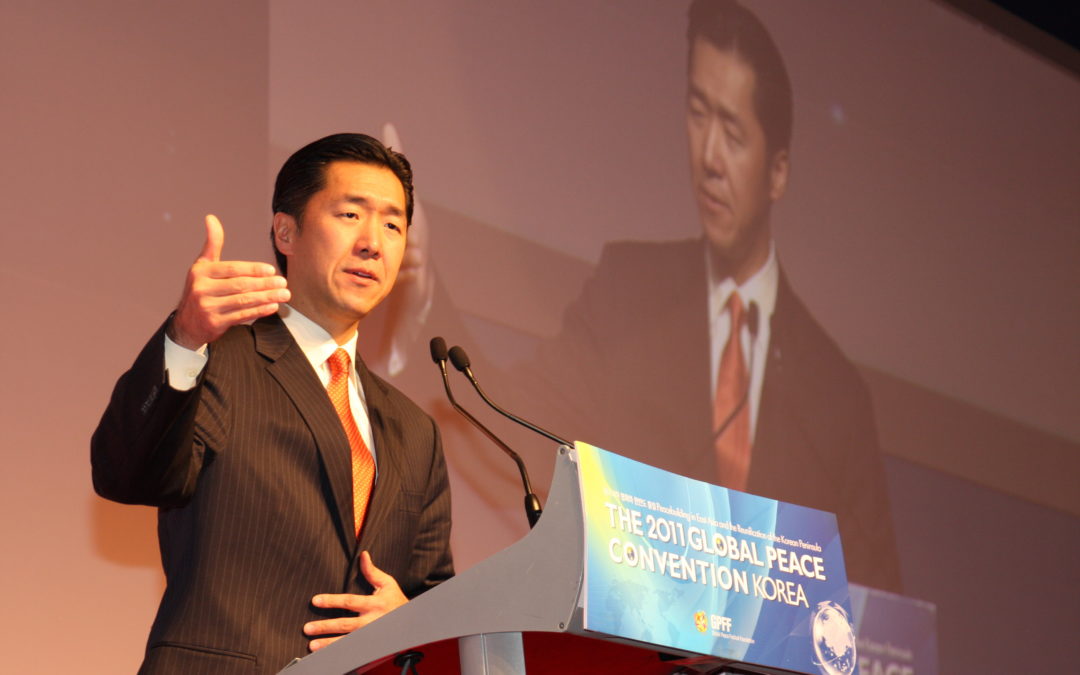The following speech was delivered at the Global Peace Conference in Seoul, Korea under the theme, “Peace-Building in East Asia and the Reunification of the Korean Peninsula,” on November 28-30, 2011.
Your excellencies, honored guests, distinguished participants from around the world. It is a distinct pleasure to meet you here at the Global Peace Convention in my birth nation of Korea. Thank you for your participation and your continuing support in this noble cause for peace.
Let me first express my appreciation for those who have worked tirelessly to make this significant Global Peace Convention a reality. It is only through “true owners,” who are willing to make the necessary sacrifices out of their busy schedules, that the all too important work for peace is sustained.
I would like to thank the Honorable Seo Young-Hoon for serving as President of this convention, and the Honorable Lee Ki-Taek for serving as Honorary President. I would also like to acknowledge the bold leadership of our Organizing Committee Co-Chairmen, the Honorable Song Young-sun of the Korean National Assembly and the Honorable Jose de Venecia, the longtime Speaker of the House of Representatives in the Philippines and founding president of Centrist Asia Pacific Democrats International. We extend special appreciation to the Korean Ministry of Foreign Affairs and Trade, the Ministry of Unification and the National Unification Advisory Council to the President for serving as co-sponsors for this convention. Let us give them and the entire Organizing Committee a warm round of applause.
Korea and the World Today
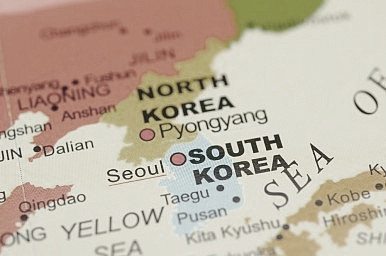
Map of the Korean peninsula
Ladies and gentlemen, Korea is known as “the land of the morning calm.” I believe that that image is a fitting metaphor for a nation poised to make a meaningful impact on the global stage. Like the rise of a new dawn at the breaking of a new day, it captures the possibility of Korea’s unique position not only on this peninsula, this region of northeast Asia and the pan-Pacific rim, but also around the world.
Over the past two years, the tensions between the North and South have been in the forefront of international news. Although many consider the Cold War to have ended during the latter part of 1980s with the collapse of the Soviet Union, it has not ended on this peninsula. The two Koreas are officially still at war, maintaining an unstable détente through the monumental efforts of the Korean people and the intervention of their powerful neighbors.
The story of post-war Korea is a narrative of two opposing visions for the Korean people and the world. Yet, after 60 years, it is remarkable that, unlike its brethren to the north, the South continues to develop in ways that have earned the respect of the international community as well as offering the gifts of modernity, wealth and freedom to its citizens. It is a clear testament to the resilient spirit of the Korean people that, despite the challenges of a civil war, the South could so dramatically improve its destiny, while the North languishes in famine, poverty and oppression.
Yet, the narrative is still not over since Korea stands as a house divided with the fate of the entire Pan-Pacific rim standing in the balance. Thus, to close the chapter on the Korean War and the continuing uncertainty of the peninsula’s fate, the Korean people, both North and South, has to resolve their differences and come together centered upon one vision for a united Korea. What will that vision be? And what would that vision mean and represent to a reunified Korean people? These are questions that we, as Koreans, must address if we are to find a path to reconciliation and eventual reunification.
In addition, it is important for the Korean people and the world to realize that the effects of any major shift on the peninsula, whether good or bad, would have regional and global consequences. Being a peninsular nation, it straddles the continental historic and cultural sphere of the Asia and the island and western cultural spheres of the Pan-Pacific rim. It is important to also note that this region represents the most animated and robust economies as well as the being the center of all the global powerhouses such as the United States, China, Russia, Japan, India and the growing ASEAN block. The rise of these powers represents a shift from the Atlantic era of the past five centuries to the dawning of a Pacific era that will leave an enduring legacy for humanity’s future.
We have reached an inflection point in human history where the circumstances, today, are preparing the world for a paradigm shift of major proportions which could positively or negatively affect this century and our collective futures. Korea stands in the vortex of that historic shift and its fate will affect the lives of not only the Koran people but the entire northeast Asian region, the Pan-Pacific rim and the world. Being a man of faith and a Korean, I cannot but feel the hand of divine providence guiding these developments and the importance of this moment for my birth nation of Korea.
Universal Aspirations, Principles and Values
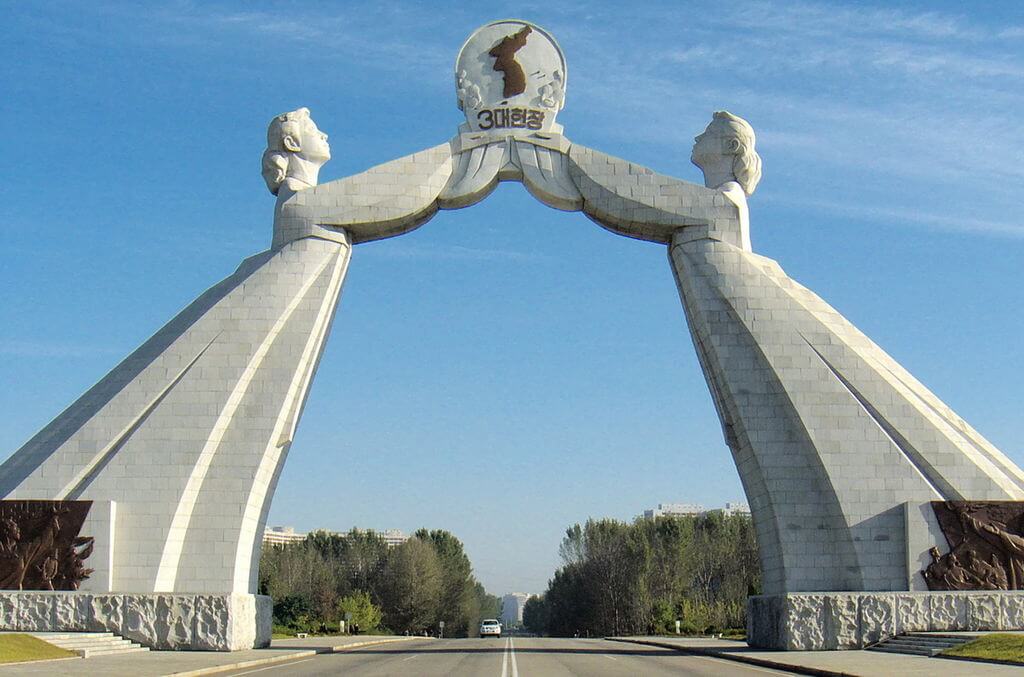
Arch of Reunification (Photo Credit: Kok Leng Yeo, Wikicommons)
What is the compass that can help us navigate these historic changes to achieve a world of peace and prosperity? I submit to you that it is a shared spiritual vision for humanity based upon universal principles and values.
We Koreans owe a great debt of gratitude to the United Nations and the sixteen nations that fought in the Korean War to preserve the freedom of the Republic of Korea. Their and the Korean peoples shared sacrifices in blood paid for the “Korean miracle” we are experiencing a possibility. As all of you know, the UN was created after World War II to avoid future conflicts by promoting the ideals of fundamental human rights and freedoms, and intervening in the most pressing global issues of the day.
However, the UN’s lofty goal of preventing future conflicts has yet to be achieved, despite many well-intentioned efforts, because it failed to acknowledge that the source of our fundamental human rights and freedoms is our Creator, and not by human design, institution or government. The spirituality of our humanity is the well from which our shared aspirations, principles and values flow. However, this resource has not been tapped to establish a recognized global ethic. Without a shared ethic there can be no global common ground for dialogue, understanding and conflict resolution.
The United States’ Lesson for the Modern World
Ladies and gentlemen, during its remarkable rise in the 20th century, the power, influence and wealth of the United States has been both admired and envied. Throughout its history, people from all over the world emigrated there to share in the “American dream.” As a 1st generation American, I have often asked myself the question: what is the essence of that dream?
For me, the American dream is not about a bigger house, a second car or even better opportunities for my children. It is not even about democracy or the free market economic system. Without the vitality of spiritual principles and values that have animated the American people the systems of democracy and the free market would have had a far different expression than that we see and admire in the United States.
Those enduring and “self-evident” principles and values are expressed in the Declaration of Independence, the American vision statement, which recognizes the existence of “inalienable rights” that are “endowed” by our Creator, placing them beyond the reach of any state or human institution. Thus, the American dream was to live in “one nation under God,” where the sovereignty of the Creator guarantees “life, liberty and the pursuit of happiness” for all its citizens. It set the precedent for our modern understanding of human rights and freedoms and the basis of a growing global ethic.
The American dream led the United States to prosper and inspire other nations throughout its short history. After the end of the Second World War, this dream was the inspiration behind the US effort to create the United Nations. Yet, under the dark cloud of the Cold War, the true source behind the rights and liberty that many in western-style democracies took for granted was not fully acknowledged. After the counter-cultural revolution of the 1960s, a secularization of human rights and freedoms occurred in the West, especially in the United States and Europe, where faith and spirituality were slowly removed from the civic square.
Nevertheless, everything changed after September 11, 2001. In our post-9/11 world, where radical expressions of faith embrace the tactics of religious war, the need to mitigate the divisiveness of narrow religious advocacy becomes obvious. It is clear that a broader consensus on a spiritual platform rooted in aspirations, principles and values is urgently needed to stop the trend towards a global religious conflict. The United States has already established a model, on a national level, where religious freedom is one of many guaranteed rights afforded to every American citizen. Yet, this ideal is not recognized by many nations in the international community.
Ladies and gentlemen, it is time for us to dream big and adopt a global vision rooted in spiritual aspirations, principles and values. It has to have the breadth and the scope to transcend all the barriers that separate humanity and build a common identity without diminishing the unique attributes that each of us exhibit and cherish. It also needs a national advocate that can communicate this vision to the larger global community. I believe that that vision is “One Family under God” and that a united Korea should champion that vision around the world.
The Korean Dream
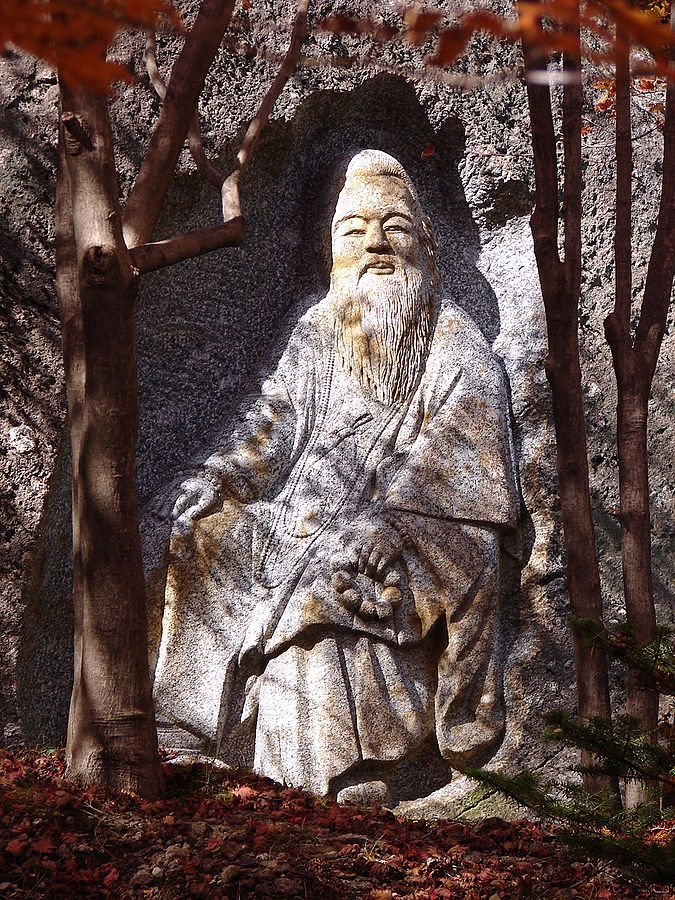
Engraved image of Hwanim, Lord of Heaven, at Samseonggung, a memorial of the founding figures of Korean history.
I call this vision the Korean dream since it provides a framework for reunification and Korean leadership on a global stage. Koreans are no strangers to the importance of such a vision. They have always been altruistic and big dreamers. More than two thousand years ago, in the ancient country of Gojosen, our ancestors were guided by the philosophy of “Hong Ik In Gan” or “for the greater benefit of mankind.” Koreans, today, are still familiar with this idea in both North and South Korea.
Yet, most Korea experts will acknowledge that reunification poses great challenges. There is a huge economic disparity between the North and South, far greater than that between East and West Germany. Equally important are the cultural and social differences between the two countries, even though they are ethnically the same. In order to understand its magnitude, one only needs to observe how much difficulty North Korean defectors have in adapting to the simple everyday realities of life in Seoul.
As I mentioned earlier, Koreans can only, seriously, meet the challenges of reunification if we, both in the North and South, are clear about what kind of country a united Korea should be and have the commitment to build such a nation together. I believe that that national vision should be rooted in universal principles and values based upon the shared aspirations of all humankind. This is the only way we can safeguard the human rights and freedoms that South Koreans currently enjoy, and guarantee those same privileges to the North.
Ladies and gentlemen, this is a time of great opportunity for Korea, on a regional and even a global stage. The global financial crisis struck the developed western economies of the northern hemisphere the hardest, leaving the emerging nations of the southern hemisphere relatively unscathed. As a result, the developing world is fundamentally questioning the hitherto dominant western models of development and leadership. Many of them are looking to Korea because of its recent rapid economic development and its more traditional Asian culture.
Yet, to be a true global leader, Korea needs to offer more than the promise of a strong economy and recognized global corporate brands. To understand my point, one only needs to look to Korea’s neighbor, Japan. Although it is the third largest economy today, for the last several decades it was ranked second in the world after the United States. During that tenure, beyond the plethora of consumer goods, what significant historic contribution has Japan made to the region of Asia and the world? Does Korea want to follow this example or does it want to offer a new kind of leadership that can affect the destiny of Asia and the world?
To dream big and chart a new path of global leadership, like our ancestral philosophy of Hong Ik In Gan, Koreans should be moral and innovative leaders. In order to truly be a leader of any merit or worth, one must have the gravitas of moral authority. In other words, a true leader’s position should not reflect any self-serving personal or political interests but benefit “the greater good” of humanity. Thus, the moral aspect of leadership provides a vision rooted in universal aspirations, principles and values, while the innovative aspect of leadership provides the methods through which that vision can be realized. They are like the two sides of a coin.
If all Koreans can become the moral and innovative leaders who truly own the reunification process and, together, build a common national destiny; then, they can capture the imagination of all people, since peace and hope on the peninsula would be felt throughout the region and the world. As Koreans, this is our challenge and, at the same time, our opportunity to be global leaders. I urge all Koreans to seize this historical moment and lead the world to peace and co-prosperity through the vision of “One Family under God” and champion the ideals of fundamental human rights and freedoms in this emerging era of the Pan-Pacific rim.
Korean Peninsula Peace Initiative and the Asian Region
Ladies and gentlemen, in this context, the Global Peace Convention and its theme of “Peacebuilding in East Asia and the Reunification of the Korean Peninsula” could not be more timely. Distinguished delegates from around the world have assembled to put forward important scholarly ideas, and interfaith and service initiatives which will contribute to a roadmap for peace in East Asia and the Korean Peninsula.
The regional dimension is crucial as President Obama’s recent trip and the regional meetings in Hawaii and Indonesia bear witness. We have to recognize that our world has entered the Pan-Pacific Rim era in which the nations of Asia along with the United States must find common cause. What happens between North and South Korea is inextricably linked to the surrounding actors of Russia, China, Japan, Mongolia and the larger neighborhood of Pacific nations including the United States and ASEAN countries.
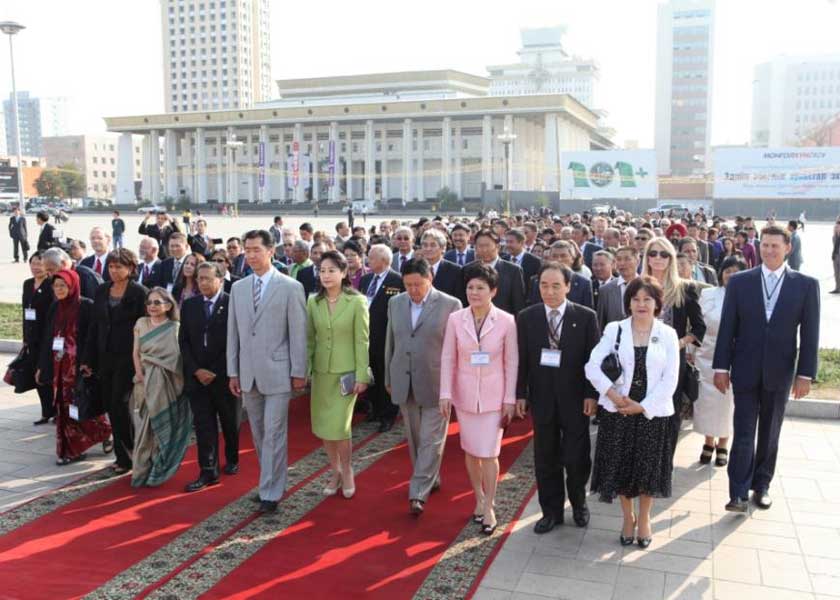
Global Peace Leadership Conference participants in Ulaanbaatar’s Sukhbaatar Square for Wreath Laying Ceremony
This Global Peace Convention in Seoul and its preceding Global Peace Leadership Conference in Mongolia have begun to frame and generate a whole array of partnerships across the region. Our GPF Northeast Asia and Korean Peninsula Peace Initiative is being launched in Mongolia and Korea, and across East Asia with a wide range of public-private partnerships. This new GPFF track two peace initiative of civil society joining in partnership with national governments, corporations and philanthropy has already established a track record for conflict resolution and peace in hot spots around the world from Mindanao in the Philippines, to Nepal and Kenya.
A key part of this conference is the launch of an ongoing East Asia Parliamentary Caucus including not only Korea and its neighbors but parliamentarians from Southeast, South and Central Asia and the United States. Together they will open up new communication channels with North Korea to secure the foundation for a peaceful community in Northeast Asia.
We are also pleased to announce the launching of the Asia Institute which will help create a road map for the reunification of North and South Korea, through collaborations with other think tanks, universities and experts in the world of policy and academia.
Conclusion
Ladies and gentlemen, we stand at a crossroads in history. The choices we make now, and the leadership we exhibit, will have far-reaching impact on the future, not in East Asia, but throughout the world.
I want to challenge the nation of Korea to dream big and take on the mantle of global moral and innovative leadership. I want to challenge a new generation of Koreans to become masters of their own destiny as their fathers and grandfathers did after the Korean War.
Let us pave the path to peace and reconciliation on this peninsula through the unifying vision of “One Family under God.” Let us also become regional leaders who can arbitrate the interests of Korea’s powerful neighbors to maintain peace and stability in the Northeast Asia and the Pan-Pacific rim; and, most importantly, let us become global leaders by championing the ideals of fundamental human rights and freedoms rooted in universal principles and values. Thereby, let us set the stage for a global ethic which could be the common ground for true dialogue understanding and conflict resolution.
I encourage you to pour your best ideas, talents and resources into the deliberations of this global convention and its culminating Seoul Declaration. Let us work together to realize a world of true peace in which not only human rights are respected, and democratic values are enjoyed, but also material abundance is secured, and spiritual values are fulfilled.
Let us not rest until the dawn of peace on the Korean peninsula, which will cast a bright ray of hope to all the world’s peoples. May God bless you and your families. Thank you very much for joining us in this noble undertaking.

